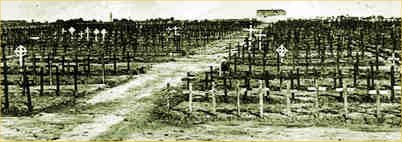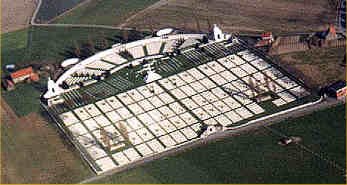
|
Whitby High School
Battlefields Tour 18-21st March 2006
Belgium - Ypres and Salient Tour - Sunday 19th March
|

|
Private William Ashbrook
10th Battalion Cheshire Regiment
Died 16th April 1918
Private William Ashbrook
NB. At present it is unclear whether or not this is William senior or junior. No war record exists for either father or son and no war documents so far show age. ‘Soldiers Died’ records his birth place as Anderton, Cheshire. This would suggest it was William junior who was 13 on the 1911 census, born in Anderton.
William Ashbrook junior was born in Anderton, near Northwich, Cheshire in 1898. His father William senior, was born in 1875 in Kelsall, Delamere, and moved to Ellesmere Port in the late 1890s to find work at Burnell’s Galvanised Iron Works. By 1911 he was living at 2 Back Grosvenor Street, Ellesmere Port, working as a pickler, still in the Iron Works.
William Ashbrook junior was likely to have been conscripted which came into force in January 1916 as he wasn’t 18 until later that year. Like many other local men, he was posted to the 10th Cheshire Regiment.
The 10th (Service) Battalion, as it was officially known, was originally formed at Chester on 10 September 1914 and quickly moved to Codford St Mary. By November 1914 they were in billets in Bournemouth. Another move followed in May 1915 to Aldershot, to complete their training and on 26 September 1915 they landed in France. William would have followed a similar path of intensive training before being despatched to France, although officially this could not happen until he was nineteen. He was probably at the Front during 1917.
When the 10th Cheshires originally went over in September 1914, they were concentrated in the area of Nieppe. On the 26th of October they transferred to 7th Brigade still with 25th Division. Their first action was in defence of the German attack on Vimy Ridge in May 1916. They then moved to the Somme and joined the Battle just after the main attack, with 75th Brigade making a costly attack near Thiepval on the 3rd of July. The Division was in action at The Battle of Bazentin, The Battle of Pozieres and The Battle of the Ancre Heights.
In 1917 they had moved to Belgium on to the Ypres Salient and were in action at The Battle of Messines, attacking between the Wulverghem-Messines and Wulverghem-Wytschaete roads. William is likely to have been involved in the latter.
In the Third battle of Ypres they were in action during The Battle of Pilkem. In early 1918 they were again fighting on the Somme, then from 9th to 29th April in the Battles of the Lys where they suffered heavy losses.
On 21 March, the German army had launched Operation Michael, their last major assault on the British troops holding positions in the heart of the Somme battlefield. The second phase of the offensive would take place further north, around Hazebrouck and Bailleul.
The Regimental History notes that the Cheshires "fought well as always, but in the bewildering succession of withdrawals, regimental officers and men lost their bearings and though willing and ready to fight, and by no means feeling beaten or disheartened , did not know where best to go."
Consequently, there is a distinct lack of detail in the various Battalion War Diaries during April 1918, due to the devastating effect of the attacks, the lack of time, and the fact that many of the responsible officers had been killed in action.
At the start of the battle, the 10th Battalion was in reserve at catacombs at Ploegsteert, near the Belgian border with France. The War Diary records that at 3am on the 10th, the "enemy bombard catacombs with gas shells and continued for 2 hours, when he bombarded with heavies". At 7am, the Cheshires were ordered to occupy Ploegsteert Wood, but they found the enemy already there. An attempt was made to attack but this failed and the Cheshires withdrew to an outpost line 400 yards in front of the catacombs. By the evening, they and a Battalion of Wiltshires were still holding a salient pushing towards the wood. Just after midday on the 11th, orders were issued to withdraw, from their positions in catacombs at Hill 63 at 5pm. In a terrible misunderstanding, the Cheshires believed that they had been ordered to "hold out to the last". The enemy attacked and surrounded the catacombs. Only small groups managed to escape and fight their way to safety, while many were captured.
By 16 April, the remnants of the 10th Cheshires had been formed into a composite unit with other troops and, in the evening were withdrawn into reserve. Thirty more men were killed that day and among them William York Ashbrook. His body was never recovered from the battlefield and he is remembered on the Tyne Cot Memorial Panels to the Missing near Ypres, Belgium (Cheshire Regiment Panels 61 to 63).
[source for the latter movements of the 10th Cheshires www.stockport1914-1918.co.uk]
 |
 |
| Craig finds William Ashbrook on the Memorial Wall |
|
 |
 |
| The Memorial to the missing where many of the Cheshires are recorded |
|
Casualty Details
|
Name: |
ASHBROOK, WILLIAM |
|
Initials: |
W |
|
Nationality: |
United Kingdom |
|
Rank: |
Private |
|
Regiment/Service: |
Cheshire Regiment |
|
Unit Text: |
10th Bn. |
|
Date of Death: |
16/04/1918 |
|
Service No: |
243690 |
|
Casualty Type: |
Commonwealth War Dead |
|
Grave/Memorial Reference: |
Panel 61 to 63. |
|
Memorial: |
TYNE COT MEMORIAL |
Certificate
In Memory of
Private WILLIAM ASHBROOK
243690, 10th Bn., Cheshire Regiment
who died
on 16 April 1918
Remembered with honour
TYNE COT MEMORIAL

Commemorated in perpetuity by
the Commonwealth War Graves Commission
|
Tyne Cot Memorial, Zonnebeke, Near Ypres, West Vlaanderen, Belgium
 The name is said to have been given
by men of the Northumbrian Fusiliers who fought here in 1917, who saw a
similarity between a nearby ruined barn and cottages in Tyneside. A
cluster of five German pillboxes stood here - just below the crest of the
Passchendaele ridge. Immediately in front of the pillboxes was a low lying
area that contained some of the worst and deepest mud in the Saiient. The
position fell to Australian troops on 4th October 1917. The name is said to have been given
by men of the Northumbrian Fusiliers who fought here in 1917, who saw a
similarity between a nearby ruined barn and cottages in Tyneside. A
cluster of five German pillboxes stood here - just below the crest of the
Passchendaele ridge. Immediately in front of the pillboxes was a low lying
area that contained some of the worst and deepest mud in the Saiient. The
position fell to Australian troops on 4th October 1917.
As the fighting moved towards Passchendaele village, the pillboxes were
used as advanced dressing stations, and it was around these that the
original battlefield cemetery of 300 burials grew. Tyne Cot lies less than
1 kilometre from Passchendaele and it took the Allies another month to
cover the distance. The site grew steadily in the 1920's as small
battlefield cemeteries were closed down and the burials moved here, and as
bodies were recovered from the battlefields as they were cleared. This
latter point explains the unusually high proportion of unidentified
burials. |
 Today Tyne Cot is the biggest
British military cemetery in the world, with 11,956 burials. The panels in
the back wall hold the names of 34,888 missing. The two forward (fighting)
pillboxes can be seen to the left and right of the entrance. The central
(command) box was incorporated into the Cross of Sacrifice, at the
suggestion of King George V who visited the site in 1992. The two rear
(rest) boxes form the foundations of classical pavilions on either side of
the rear wall. The original burials are the less regularly arranged rows
above the Cross of Sacrifice. The cemetery was designed by Sir Herbert
Baker. Today Tyne Cot is the biggest
British military cemetery in the world, with 11,956 burials. The panels in
the back wall hold the names of 34,888 missing. The two forward (fighting)
pillboxes can be seen to the left and right of the entrance. The central
(command) box was incorporated into the Cross of Sacrifice, at the
suggestion of King George V who visited the site in 1992. The two rear
(rest) boxes form the foundations of classical pavilions on either side of
the rear wall. The original burials are the less regularly arranged rows
above the Cross of Sacrifice. The cemetery was designed by Sir Herbert
Baker.
|

Tyne Cot is located north of Zonnebeke (No.1)

Tyne Cot Memorial Wall to the Missing
Cheshire Regiment Panel
Return to Soldier's Visited Page
www.roydenhistory.co.uk
Visit the Royden History Index Page listing web sites designed and maintained by Mike Royden
No pages may be reproduced without permission
copyright Mike Royden
All rights reserved
 The name is said to have been given
by men of the Northumbrian Fusiliers who fought here in 1917, who saw a
similarity between a nearby ruined barn and cottages in Tyneside. A
cluster of five German pillboxes stood here - just below the crest of the
Passchendaele ridge. Immediately in front of the pillboxes was a low lying
area that contained some of the worst and deepest mud in the Saiient. The
position fell to Australian troops on 4th October 1917.
The name is said to have been given
by men of the Northumbrian Fusiliers who fought here in 1917, who saw a
similarity between a nearby ruined barn and cottages in Tyneside. A
cluster of five German pillboxes stood here - just below the crest of the
Passchendaele ridge. Immediately in front of the pillboxes was a low lying
area that contained some of the worst and deepest mud in the Saiient. The
position fell to Australian troops on 4th October 1917.
 Today Tyne Cot is the biggest
British military cemetery in the world, with 11,956 burials. The panels in
the back wall hold the names of 34,888 missing. The two forward (fighting)
pillboxes can be seen to the left and right of the entrance. The central
(command) box was incorporated into the Cross of Sacrifice, at the
suggestion of King George V who visited the site in 1992. The two rear
(rest) boxes form the foundations of classical pavilions on either side of
the rear wall. The original burials are the less regularly arranged rows
above the Cross of Sacrifice. The cemetery was designed by Sir Herbert
Baker.
Today Tyne Cot is the biggest
British military cemetery in the world, with 11,956 burials. The panels in
the back wall hold the names of 34,888 missing. The two forward (fighting)
pillboxes can be seen to the left and right of the entrance. The central
(command) box was incorporated into the Cross of Sacrifice, at the
suggestion of King George V who visited the site in 1992. The two rear
(rest) boxes form the foundations of classical pavilions on either side of
the rear wall. The original burials are the less regularly arranged rows
above the Cross of Sacrifice. The cemetery was designed by Sir Herbert
Baker.









